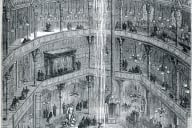You have /5 articles left.
Sign up for a free account or log in.
No Exit by Jean-Paul Sartre involves three characters who are condemned to spend their afterlives together in a shabby but not especially uncomfortable room -- “condemned” because it’s the Devil himself who brings them together. Evidently some kind of infernal algorithm has been used to select the group, designed to create optimal misery. Sartre’s dialogue is quite efficient: we soon learn the broad outlines of their time on Earth and how it was shaped by wishful thinking and self-deception.
We also see how quick they are to recognize one another’s vulnerabilities. Any given pair of characters could find a mutually satisfying way to exploit each other’s neuroses. But there’s always that third party to disrupt things, rubbing salt into old wounds while inflicting fresh ones.
In a moment of clarity, one of them finally recognizes that they are damned and utters Sartre’s best-known line: “Hell is other people.” Quoting this is easy, and misunderstanding it even easier. It sounds like a classical expression of self-aggrandizing misanthropy. But the figures on stage did not wander over from the pages of an Ayn Rand novel. They are not sovereign egos, imposed upon by the demands of lesser beings whose failings they repudiate with lofty scorn.
On the contrary, Sartre’s characters are driven by a desperate and insurmountable need to connect with other people. They crave intimacy, acceptance, reciprocity. They also seek to dominate, manipulate, yield to or seduce one another, which would be difficult enough if they weren’t trying to do more than one at the same time. The efforts fail, and the failures pile up. Things grow messy and frustrating for all parties involved. Hell is other people, but the torment is fueled by one’s own self.
That insight rings even more true in the wake of Hell Is a Very Small Place: Voices From Solitary Confinement (The New Press), an anthology edited by Jean Casella, James Ridgeway and Sarah Shourd. I doubt anyone meant the title as an allusion to No Exit. The activists, scholars and prisoners contributing to the book document a place much darker and more brutal than Sartre imagined -- but akin to it, in that the damned are condemned, not to lakes of fire, but to psychic torture so continuous that it seems eternal. (Casella and Ridgeway are co-founders of Solitary Watch, while Shourd is a journalist who spent 410 days in solitary confinement while imprisoned in Iran.)
A few basic points: solitary confinement initially had humane intentions. Quaker reformers in the early American republic were convinced that prisoners might benefit from a period of reckoning with their own souls, which would come readily in isolation from the evil influence of low company. If so, they would reform and return to society as productive members. More secular versions of this line of thought also caught on. Unfortunately it did not work in practice, since prisoners tended to emerge no better for the experience, when not driven insane. By the turn of the 20th century, the practice was being phased out, if not eliminated, as ineffective and dangerous.
Now, my sense from reading around in JSTOR is that, from about 1820 on, whenever the issue of imprisonment came up, the eyes of the world turned to the United States. Other countries had a similar rise and fall of confidence in solitary confinement over the years. But the practice took on a new life in America starting in the 1980s. The aim of reforming prisoners was no longer a factor. Solitary confinement -- warehousing prisoners alone in a cell for 23 to 24 hours a day, minimizing contact with one another and with the outside world -- permitted mass incarceration at reduced risk to prison guards.
In 2011, Juan E. Méndez, the United Nations Human Rights Council’s Special Rapporteur on Torture and Cruel, Inhuman and Degrading Treatment or Punishment, issued a report on the use of prolonged solitary imprisonment around the world, with “prolonged” meaning more than 15 days. Administrators and government officials rejected his request to inspect isolation units in American prisons. In his contribution to Hell Is a Very Small Place, Méndez writes that the best estimate for the population of those in solitary confinement in the United States at any given time is 80,000 people, “but no one knows that for sure.” The personal accounts by prisoners in the book show that confinement American-style is more than “prolonged.” It can go on for years, and in some cases, for decades.
An isolation cell is sometimes called “the Box,” and the experience of living in one for months and years on end makes it sound like being buried alive. In the chapter “How to Create Madness in Prison,” Terry Kupers describes the symptoms that appear during a long stretch. The prisoner in isolation “may feel overwhelmed by a strange sense of anxiety. The walls may seem to be moving in on him (it is stunning how many prisoners in isolated confinement independently report this experience) …. The prisoner may find himself disobeying an order or inexplicably screaming at an officer, when really all he wants is for the officer to stop and interact with him a little longer than it takes for a food tray to be slid through the slot in his cell door. Many prisoners in isolated confinement report it is extremely difficult for them to contain their mounting rage ….”
But that is far from the extreme end of the spectrum, which involves psychotic breaks, self-mutilation and suicide. In isolation, time no longer passes through the usual cycle of hours, weekdays, months. The damaged mind is left to pick at its own scabs for what might as well be an eternity.
Hell Is a Very Small Place proves fairly repetitious, though it could hardly be otherwise. Reading the book leaves one with the horrible feeling of being overpowered by routines and forces that will just keep running from the sheer force of momentum. Last year, President Obama called for an extensive review and reform of prison conditions, and last month, he issued a ban on the solitary confinement of juveniles in the federal prison system. So that’s the good news, for however long it may last. But consider the enormous obstacle to change represented by the sunk cost of millions or billions of dollars spent to erect Supermax prisons -- let alone the businesses (and lobbyists) who depend on more of them being built.
Anyone housed in solitary for a while would have to envy the characters in No Exit. They have more room (a “box” is typically somewhere between 6 by 9 feet to a luxurious 8 by 10) and they have each other, like it or not. Sartre’s hell is imaginary; it exists only to reveal something about the audience. The idea of burying people alive in concrete tombs degrades the society that has turned it into reality. The phrase “solitary confinement of juveniles in the federal prison system” alone is the sign of something utterly unforgivable.




